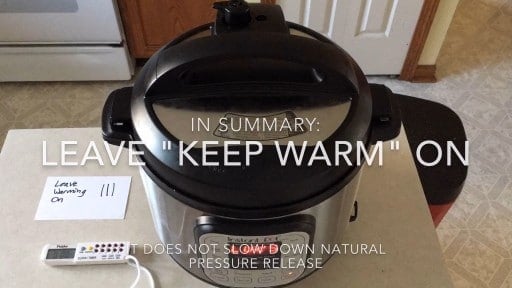
In my Instant Pot FAQ, I have the following question:
Q: What about natural pressure release? When the Instant Pot finishes cooking, it switches to Warming mode – is that OK with a natural pressure release? Or should I cancel it?
A: Cancel warming mode to speed up natural pressure release.
I was reading the Instant Pot Community Facebook group, and saw a heated debate: Keep Warm and Natural Pressure Release. One side was strongly in the “warming mode doesn’t matter” camp, the other was in the “turn warming mode off” group - and used my FAQ post as evidence.
After reading the debate, I started to wonder - am I wrong about warming mode? I assumed that turning off the heat would speed up the natural release - that the pot would lose heat quicker without any heat being added by warming mode.1 The argument against cancelling Keep Warm mode is the pot’s thermostat. Warming mode keeps the temperature between 145°F and 172°F, so it won’t turn the heat on until the temperature drops to 145°F. That’s well below the temperature where pressure will release.
I ran a quick test - I set my IP-Duo and IP-Smart next to each other on the counter, added a quart of water to each, set them for 3 minutes of high pressure cooking, and waited for it to finish. They both came up to pressure and counted down the three minutes at about the same time. I cancelled the Keep Warm mode on the IP-Smart, and waited for the pressure indicators to drop. Much to my surprise, the IP-Duo finished manual pressure release about five minutes before the IP-Smart!
But…is that a valid test? Maybe there is something about the IP-Smart that slows down cooling. To reduce the variables, I ran the test over and over again with my IP-Duo, a quart of water at high pressure for 3 minutes, and alternated leaving Keep Warm mode on and off.
Sitting and watching natural pressure release is only slightly less interesting than watching grass grow. So, instead of babysitting each run, I set my Phone on a tripod and filmed it using time-lapse video mode. Here are the time-lapse videos from the third run, side by side:
You can see them finish within a minute of each other - this is consistent across all the tests. Sometimes Keep Warm mode finishes first, sometimes cancelling it does - but the difference between them was always less than a minute, and it kept moving around as to which was faster. 2
In summary...
Keep Warm mode doesn’t affect natural pressure release. It finishes at about the same time either way, so don’t bother canceling it. I was wrong in my Instant Pot FAQ; I’m sorry I gave you bad information. (And, of course, I updated the FAQ to match this new info.)





Simon Ratcliffe says
Perfect info. Thanks so much for clearing this up.
Misty says
Googled the question of turning off the Instant Pot when allowing a natural release, and like a miracle, the clouds parted and the heavens shone down directing me to your site. I bow before your expertise and offer my sincere thanks. I only wish I had brought with me some token item of appreciation—like frankincense...or myrrh. What is myrrh? ::sigh:: Back to Google—after bookmarking.
Simon Ratcliffe says
Haha
Linda says
Awesomesauce! Thank you, now I know what I'm doing... a bit more. 😀
Kim says
Thank you!! Exactly the information I was looking for.
Geri says
Thank you for doing the test--multiple times, and explaining the results as well as how the 'keep warm' feature works.
Rita says
To avoid spewage during a quick release, I simply drop a folded terrycloth dishcloth over the valve before quick-releasing the pressure with a pair of tongs.
Pair of tongs? It's one tongs? One tong?...But I digress.
Some folks use a folded kitchen towel. It also keeps the burst of steam (and any fatty particles from the cooking liquid) from coating the front of my cabinets.
Shanna says
Getters, pronounced "gitters" in the south.
Jo says
So...can you start a whole chicken in the AM when you leave for work, and rely on the insta pot to keep it at a safe temperature until 5:00 when we get off work? This was never a question with the crock pot, but one I have with the insta pot.
Mike Vrobel says
The instant Pot "keep warm" mode runs for 10 hours after cooking, so that should work.
Betty says
Who knew about the 10-hour run on Keep Warm? Thank you for stating it. I'm about to write that in my IP Ultra manual.
Diane says
It was always a pain to babysit my Instant Pot while making batches of stock. Natural pressure release was always a race to turn off "keep warm" so natural pressure release would not take so long. Now I can go take that nap... I mean do something constructive like Dust... yeah that's what I meant... Dust! Thank you for the revelation! Also, thank you for all these wonderful recipes. I'm really enjoying your site.
Carrie says
Thank you for your time in experimenting and posting your results. My question is solved and I can cook with confidence. Thank you, thank you!
Bethany says
I made my first chuck roast last night in the instant pot. I had never used it before and I didn't quite understand the pressure release issue. After browning, and adding 1 1/2 cups beef broth, I cooked my roast on "stew/meat" for 55 minutes. I then let it switch to warm mode and waited about 10 minutes, and not seeing that any steam was escaping, I started to vent the steam myself. The roast was not as tender as I was expecting, in fact, parts were tough. Should I have left it alone longer on warm? And when you do that, do you visibly see steam escape eventually? How do you know when its finished venting? Also, I guess next time I should use the manual mode? I am wondering how to make the meat more tender. THANK YOU.
Mike V says
I go Manual, 75 minutes, with a natural pressure release, for chuck roast:
https://www.dadcooksdinner.com/pressure-cooker-beef-pot-roast-2/
You will not see steam escape when the pressure drops naturally. After 20 minutes or so, the float valve will drop, unlocking the lid. (It's the round silver pop-up, next to the black steam release handle.) You can also twist the steam release handle to check if it is still under pressure - if it releases steam, turn it back to closed.
Terry Burgess says
My question is regarding "quick release". My fear is of spewage. Some have suggested not to quick release because of this while others do suggest using the quick release. I don't want a mess in my kitchen. Your thoughts or answers will be greatly appreciated. Thanks
Mike V says
I use natural release 60% of the time, and quick release 40% of the time. Quick release is noisy and does throw a lot of steam...but most of the time it is just that, steam. Every once in a blue moon the quick release starts hissing and spitting and spraying a fine mist of stuff out; when it does that I close the valve and let it cool off some more before re-starting the quick release.
chickenchupacabra says
Thank you!
Marlene says
Thank you for taking the time to do the test. I am new to Instant Pot pressure cooking and was just wondering that same thing today.
Pierce Presley says
How could I have a pot so smart and think it was so dumb as to heat the pot right after pressure cooking? I may not be qualified to operate this thing.
Andy says
That's really interesting - and makes using the IP even simpler.
It never even occurred to me that the keep warm function was thermostat-controlled; I just assumed that it was a low, constant heat.